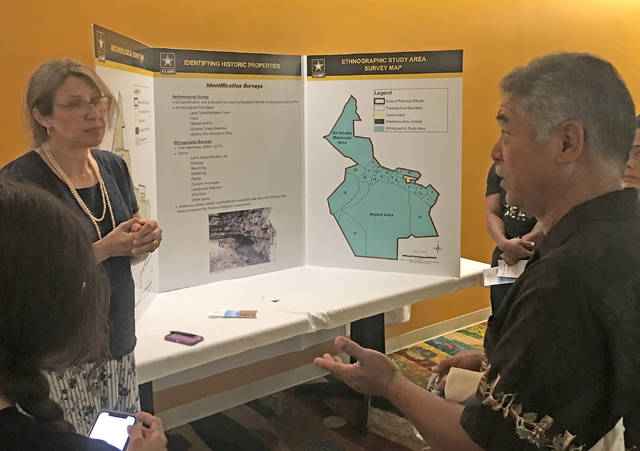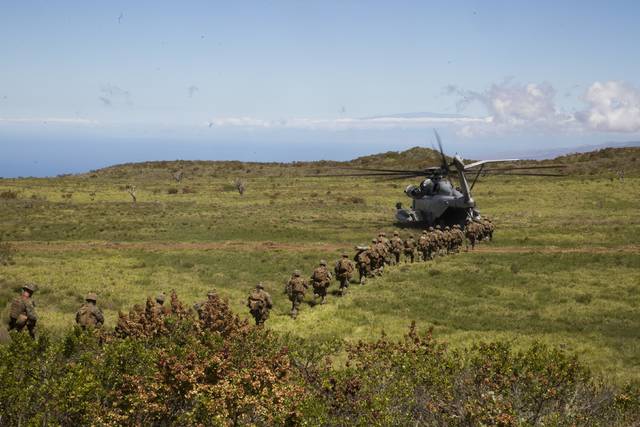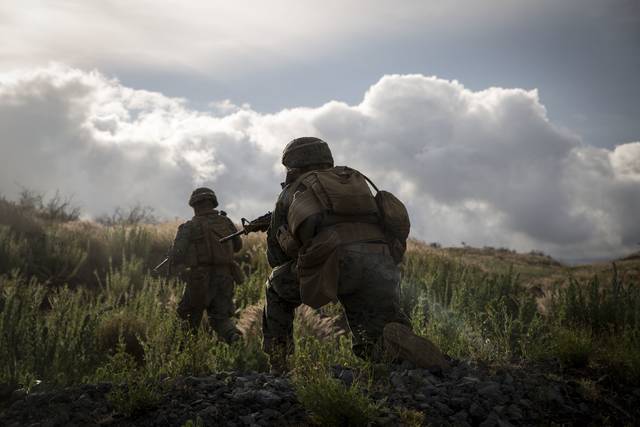Army training effects up for comment




KAILUA-KONA — A programmatic agreement that officials say will streamline and improve management of historic resources at two Army installations on the Big Island is up for public comment.
KAILUA-KONA — A programmatic agreement that officials say will streamline and improve management of historic resources at two Army installations on the Big Island is up for public comment.
The draft agreement lays out how the Army proposes to avoid, minimize and resolve any potential effects routine training and related activities may have on historic properties in accordance with Section 106 of the National Historic Preservation Act.
It covers Kawaihae Military Reservation and Pohakuloa Training Area, where lava tube habitation sites, trails, pahoehoe pits, volcanic glass quarries and historic habitation sites have been identified.
Routine military training includes physical training, maneuver training, aviation training, landing zone and drop zone training, and live-fire training, among others, according to the draft agreement.
Military training-related activities comprise configuration, maintenance, and repair of the ranges, facilities, utilities and other infrastructure within training areas; explosive ordnance disposal; cultural and natural resources management; and wild land fire management, according to the agreement, the draft agreement reads.
If signed into effect, the agreement will consolidate previous and new Army cultural resource commitments in a single, agreed-upon document. That includes two currently in effect programmatic agreements, one which expires this year and the other in 2021.
Ski Kwiatskowski, a member of the Royal Order of Kamehameha Kohala Chapter, said his biggest concern about the agreement is the potential for it to be used as a “free pass.”
“Our concern really is that we don’t give someone carte blanche — you don’t want to have someone to have a piece of paper that says we don’t have invoke 106 to anybody, anymore. We just do what we want,” he said. While he understands that a 106 procedure would be triggered if there is an instance the training activities does not conform with the programmatic agreement, Kwiatskowski said he wants to ensure that all consulting parties to the agreement are notified to provide input, not just the signatories to the document.
Kwiatskowski was among a couple dozen people who turned out for an informational session held by the U.S. Army Garrison Hawaii Thursday evening at King Kamehameha’s Kona Beach Hotel.
It was the second of two held on the island regarding the draft agreement that’s been in the works for more than three years. The first session, held Wednesday in Hilo, attracted several dozen people.
“It makes it more transparent,” PTA Commander Lt. Col. Loreto V. Borce Jr. said of the draft agreement. “Whatever occurs on the programmatic agreement, that’s what we’re doing. If there’s something we’re doing outside of the programmatic agreement, we have to consult. It’s keeping everyone informed, so they can understand what is going on on the military side so that no one has questions about it.”
The draft agreement was developed through consultation with the Advisory Council on Historic Preservation, the State Historic Preservation Officer, Native Hawaiian organizations and other consulting parties, as well as incorporating input from the public-at-large.
After comments are received and input is added, the agreement will be put out for final review by the State Historic Preservation officer and Advisory Council. If those parties agree with the version, the PTA garrison commander, State Historic Preservation officer and Advisory Council sign the document, making it effective for 15 years.
The Army says the agreement will help it meet the intent of Section 106 by streamlining review of routine and recurring training actions and related activities on the island by reducing administrative time and paperwork for the all those involved in creating the document.
Gregory Fleming, deputy garrison commander at Pohakuloa, described the in-progress programmatic agreement as a “set of business rules.”
“It lays out how we’re going to identify and how we’re going to resolve any conflicts between our training and our cultural resources,” Fleming said.
For example, under the agreements in place as well as the draft agreement, when a unit wants to train, PTA is notified four months in advance and a pre-deployment site survey is conducted on a specified area to determine if any historic properties exist there. If such items don’t exist in the area, range and cultural resource officials next look at whether the type of training is permitted in the area.
“That’s the question: What type of training do you want to do and where do you want to do it. And they’ve got match up with what we’ve surveyed and what we say is OK to train in,” explained Fleming. “If they don’t, we have those business rules or protocols to resolve those issues.”
Those protocols follow the standard Section 106 process and call for notifying the consulting parties, Native Hawaiian organizations, the State Historic Preservation officer and Advisory Council of the plans to find out more about the area’s cultural and archaeological resources. A site study is then conducted before the same consulting parties review the findings.
Sometimes, Fleming said, “it comes back that you can’t train there because we identified cultural resource sites that we want to protect. So, that may be the answer back to the unit. We’ll help you find another area but you can’t train in this area.”
The draft PA and related project information are available online at go.usa.gov/xNS7n, under “Project Documents.” Printed copies are available upon request.
Comments can be submitted via mail to Attn: Training PA, DPW-ENV Cultural Resources, 947 Wright Ave., Bldg. 105, 3rd Floor, WAAF, Schofield Barracks, HI 96857; by email to usaghi.pao.comrel@us.army.mil or via phone by calling 655-9707.



Glad to see this meeting was not mobbed by the usual anti military nitwits
This just seems like another layer of bureaucracy. Wouldn’t existing cultural and historical locations already be known and located? Why would a “team” have to go out there and survey the area every time training is proposed?